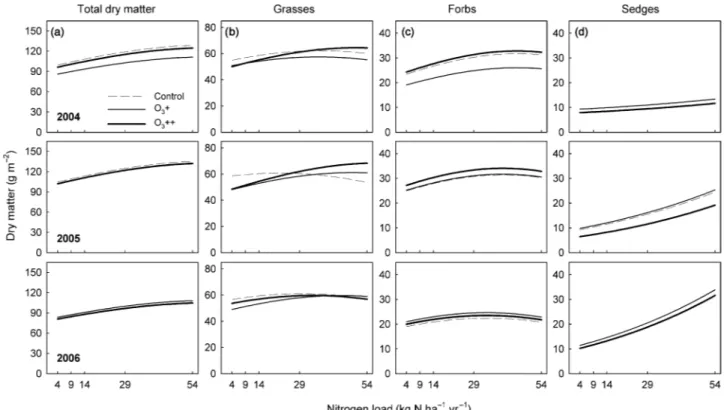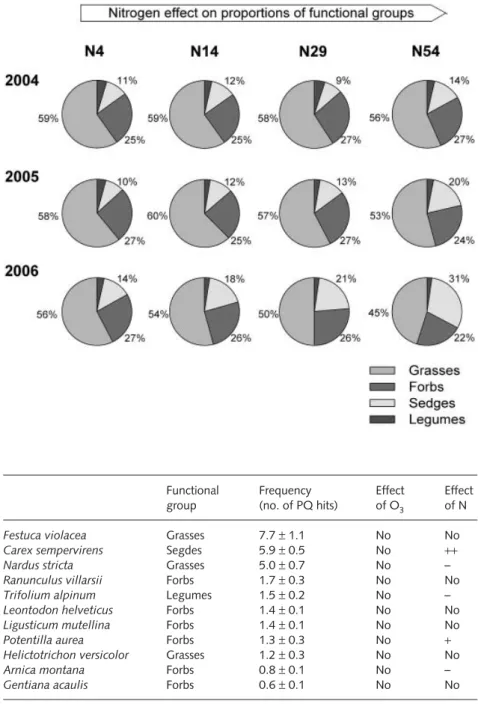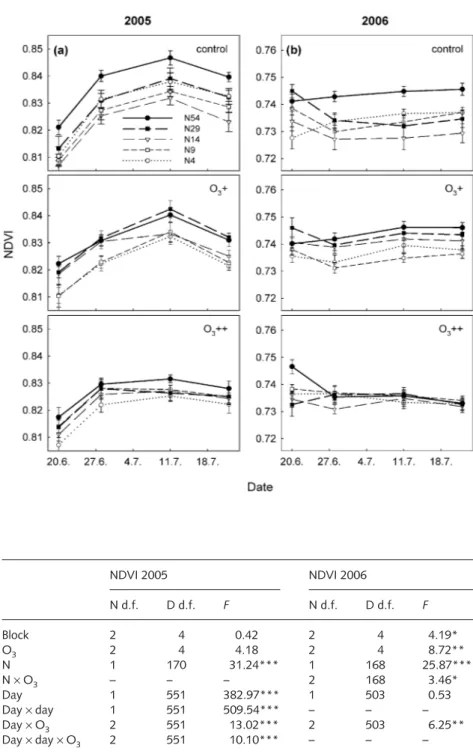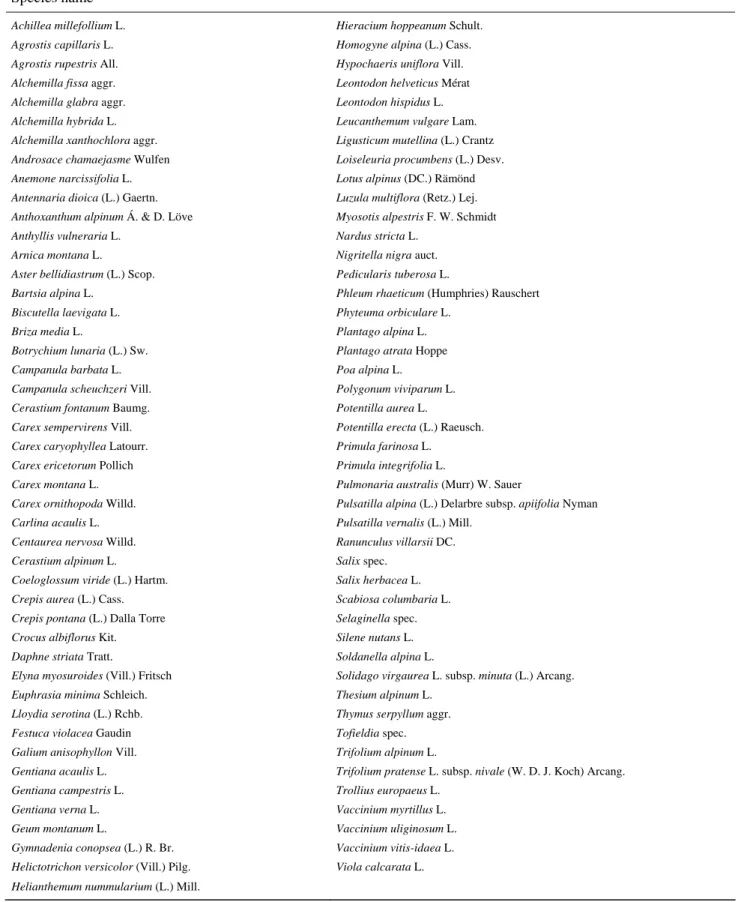www.newphytologist.org 523
Research
Blackwell Publishing Ltd
Nitrogen deposition but not ozone affects productivity and community composition of subalpine grassland after 3 yr of treatment
Seraina Bassin
1, Matthias Volk
1, Matthias Suter
2, Nina Buchmann
3and Jürg Fuhrer
11
Air Pollution and Climate Group, Agroscope Research Station ART, CH-8046 Zurich, Switzerland;
2Institute of Integrative Biology, ETH Zurich, CH-8092 Zurich, Switzerland,
3Institute of Plant Sciences, ETH Zurich, CH-8092 Zurich, Switzerland
Summary
• A field experiment was established at 2000 m above sea level (asl) in the central Swiss Alps with the aim of investigating the effects of elevated ozone (O
3) and nitrogen deposition (N), and of their combination, on above-ground productivity and species composition of subalpine grassland.
• One hundred and eighty monoliths were extracted from a species-rich Geo- Montani-Nardetum pasture and exposed in a free-air O
3-fumigation system to one of three concentrations of O
3(ambient, 1.2 × ambient, 1.6 × ambient) and five concentrations of additional N. Above-ground biomass, proportion of functional groups and normalized difference vegetation index (NDVI) were measured annually.
• After 3 yr of treatment, the vegetation responded to the N input with an increase in above-ground productivity and altered species composition, but without changes resulting from elevated O
3. N input > 10 kg N ha
–1yr
–1was sufficient to affect the composition of functional groups, with sedges benefiting over–proportionally. No interaction of O
3× N was observed, except for NDVI; positive effects of N addition on canopy greenness were counteracted by accelerated leaf senescence in the highest O
3treatment.
• The results suggest that effects of elevated O
3on the productivity and floristic composition of subalpine grassland may develop slowly, regardless of the sensitive response to increasing N.
Key words: Carex , grassland, Nardetum , nitrogen, ozone, seminatural, subalpine zone.
New Phytologist (2007) 175 : 523–534
© The Authors (2007). Journal compilation © New Phytologist (2007) doi : 10.1111/j.1469-8137.2007.02140.x
Author for correspondence:
Seraina Bassin Tel: + 41 44 377 75 08 Fax: + 41 44 377 72 01
Email: Seraina.Bassin@art.admin.ch Received: 16 February 2007 Accepted: 25 April 2007
Introduction
During the last century, concentrations in the troposphere of ozone (O
3) and reactive nitrogen compounds (N) have risen substantially on a global scale as a result of increasing anthropogenic emissions (Matson et al ., 2002; Ashmore, 2005). Today many regions are exposed to O
3concentrations and N deposition rates that exceed preindustrial values several-fold (Volz & Kley, 1988; Preunkert et al ., 2003). In Switzerland, current annual rates of N deposition in remote
mountain areas are around 5 kg N ha
–1yr
–1, but reach up to
60 kg N ha
–1yr
–1in regions with intensive livestock farming
(Rihm & Kurz, 2001). Both N input and O
3have been found
separately to affect plant communities of natural and
seminatural habitats in ways that threaten the structure and
function of these systems (Ashmore, 2005; Phoenix et al .,
2006). To protect sensitive communities from excess pollutant
input, effect-based abatement strategies applying critical
concentrations for O
3and critical loads for N have been developed
under the UNECE Convention on Long–range Transboundary
Research 524
Air Pollution (CLRTAP). However, owing to the lack of suitable experimental data, possible interactive effects of O
3and N have not been considered.
As an essential nutrient, atmospheric N can alter ecosystem properties such as productivity, cycling of carbon (C) and N (Vitousek et al ., 1997) or biodiversity (Stevens et al ., 2004).
In particular, in natural and seminatural ecosystems species characteristic of nutrient-poor conditions may be displaced by a few fast-growing and highly competitive species (Bobbink et al ., 1998). When, as a result of increasing nutrient availability, below-ground competition for resources shifts to above-ground competition for light, species that effectively invest available N into high relative growth rates are favoured (Schieving & Poorter, 1999), as observed in several N addition experiments in dune vegetation (van den Berg et al ., 2005) and calcareous grasslands (Bobbink, 1991).
Herbaceous systems in climatically extreme environments such as mountain regions may be most susceptible to even low rates of N addition, as suggested by Bowman & Steltzer (1998). These systems are currently marginally exposed to air pollutants, and in the absence of high concentrations of N input they are typically nutrient-poor and species-rich, and thus of high conservation value. In the alpine zones, N addition experiments concentrated on unmanaged alpine heaths (Soudzilovskaia & Onipchenko, 2005) and tundra (Theodose & Bowman, 1997; Bowman et al ., 2006), but little is known about effects of increasing N inputs on subalpine grasslands which play an important role for both conservation and agriculture.
Ozone is the major phytotoxic air pollutant on regional scales. There is ample evidence that current ambient concen- trations are sufficiently high to cause widespread visible O
3injury in plants in Europe and elsewhere (Benton et al ., 2000). Elevated O
3impairs photosynthesis, leaf life span, reproduction and growth (Ojanperä et al ., 1998). In species- poor productive grass/legume swards, experimental exposure to elevated O
3consistently caused an increase in the dominance of grasses at the expense of legumes (cf. Fuhrer et al ., 1994).
In contrast, in natural multispecies communities, few available studies revealed less consistent responses with either declining (Volk et al ., 2006) or rising proportions of legumes (Evans & Ashmore, 1992), and unaffected (Barbo et al ., 1998) or reduced total yield (Evans & Ashmore, 1992; Volk et al ., 2006). These conflicting results suggest that in complex mature communities, multiple plant–plant and plant–environment interactions might strongly modulate the effect of O
3.
In grasslands, large variability in responsiveness to O
3stress exists among and within species (Bungener et al ., 1999;
Bassin et al ., 2004b). Recently, the responses to O
3of different species and community types have been compared (Bassin et al ., 2006; Jones et al ., 2006; Mills et al ., 2006).
Bassin et al . (2006) discussed the importance of physiological and ecological traits in determining O
3sensitivity. They suggested that a high relative growth rate with related leaf
traits such as high stomatal conductance and high specific leaf area (SLA) promote the specific sensitivity to O
3. Accordingly, low-productivity communities such as alpine and subalpine grasslands could be considered less responsive to O
3because of their high proportion of slow-growing, stress-tolerant species. In contrast, Mills et al . (2006) classified this type of grassland among the most sensitive vegetation types based on individual species’ responses to O
3observed under controlled conditions.
Theoretically, an increase in N availability and in O
3exposure could have opposing effects. Owing to phenotypic plasticity, plants might become more susceptible to O
3when growth rates are stimulated by extra available N, or alternatively enhanced detoxification capacity from N-stimulated photo- synthesis could reduce O
3sensitivity. For instance, high nutrient supply protected Plantago major against O
3damage (Whitfield et al ., 1998) and Trifolium repens from accelerated leaf senescence (Sanz et al ., 2005). However, data from in situ experiments with intact communities, including multiple treatment levels and factor combinations to test the interaction between N and O
3, are lacking.
This study was designed to investigate the long-term impact of elevated O
3and N input, and of their combination, in extensively managed grassland in the Swiss Alps. The aim was to determine: (i) total above-ground productivity; (ii) productivity and proportion of functional groups (grasses, forbs, sedges and legumes); (iii) individual species’ abundance and diversity;
and (iv) the development of the vegetation greenness as an indicator of leaf senescence, in relation to individual and combined concentrations of O
3and N deposition. Here we report results from the initial 3 yr of experiments.
Materials and Methods
Study area
The experimental site is located at Alp Flix, Sur, Switzerland (2000 m asl, 9 ° 39 ′ N/46 ° 32 ′ E), a high plateau near Julier Pass in the central Alps. The plateau, located c . 100 m below the climatic tree line, is dominated by a raised bog surrounded by extensively managed pastures and hay meadows. Climatic conditions are characterized by cold winters with permanent snow cover and a growing season from April to October.
Precipitation peaks in summer (long-term average 120–
140 mm monthly from May to September) with an annual sum of 1200 mm. Long-term mean annual temperature is 2.8 ° C, and monthly average temperatures are highest in July and August (9–10 ° C).
Vegetation and soil
The vegetation is a Geo-Montani-Nardetum , which is a typical
pasture community covering large areas in the subalpine zone
of the European Alps and Pyrenees (EUNIS classification
© The Authors (2007). Journal compilation © New Phytologist (2007) www.newphytologist.org New Phytologist (2007) 175 : 523–534 Research 525
35.1, http://eunis.eea.europa.eu/). The most frequent species are Festuca violacea , Nardus stricta and Carex sempervirens , which together account for approximately one-half of the cover. The remaining half is composed of > 70 forb and a few legume species. The low-intensity management, as a cattle pasture with c . 1.3 livestock units ha
–1grazing during 3 – 4 wk yr
–1, was replaced in the present study by a cutting regime. It is uncertain to what extent above-ground productivity and species composition might be affected in the long term as a result of the release from grazing selection and potential modifications of the nutrient turnover.
The soil is a slightly acidic cambisol (pH 4.8–6) developed on Serpentinite bedrock. Soil depth varies between 20 and 40 cm, but rooting depth is limited to a maximum of 20 cm.
Experimental design, fumigation and N deposition treatment
A free air fumigation system was installed in spring 2004, consisting of nine rings of 7 m diameter (for details of the system and of its performance, see Volk et al ., 2003). Rings were arranged in three linear blocks on a small ridge of length 150 m. The ridge is orientated east–west and orthogonal to the two main wind directions. Three fumigation treatments (ambient (control), 1.2 × ambient (O
3+ ), 1.6 × O
3ambient concentration (O
3++)) were randomly assigned to the three rings in each block. With O
3concentrations at these altitudes being mainly controlled by the global background con- centration (Staehelin et al., 1994), we aimed to increase O
3concentration during the day as well as during the night.
Exposure to elevated O
3concentrations lasted from 16 June to 25 October in 2004, from 15 April to 24 October in 2005, and from 21 April to 23 October 2006. In 2004, late snow- melt delayed the installation of the fumigation system.
Meteorological conditions allowed O
3release 74, 62 and 78%
of the time during the fumigation periods in the years 2004, 2005, and 2006, respectively. O
3concentrations were measured at canopy height in control and fumigation treatments and at reference height (2 m) in ambient air.
Experimental plots consisted of monoliths (L × W × D = 40 × 30 × 20 cm). These were excavated in autumn 2003 from a nearby pasture, placed in drained plastic boxes and randomly assigned to the rings. Boxes were placed in shallow pits flush with the surrounding surface. They were rearranged every year between the rings within each O
3treatment to minimize confounding effects of microclimatic differences between rings.
Five concentrations of N application were established to simulate atmospheric N deposition during the growing season. Extra N input in these treatments was equivalent to 0, 5, 10, 25, 50 kg N ha
–1yr
–1. These annual N amounts were separated into biweekly additions of 200 ml of a solution of ammonium nitrate in well water. Each N concentration was replicated four times in each fumigation ring. The amount of added water was equivalent to only 2% of the annual rainfall
amount, and N addition from well water was < 0.05 kg N ha
–1yr
–1. Considering the annual background deposition measured at the study site (c. 4 kg N ha
–1yr
–1, see the Results section), total N loads in the different treatments were 4, 9, 14, 29 and 54 kg N ha
–1yr
–1. In the following, treatments are referred to as N4, N9, N14, N29 and N54, respectively.
Micrometeorological measurements
Meteorological parameters were recorded at 2 m reference height outside the fumigation rings: global radiation (W m
–2), wind speed (m s
–1), air temperature (°C), relative humidity (%), and precipitation (mm h
–1). For details concerning measurement equipment see Volk et al. (2003).
Background N deposition measurements
Background N deposition was calculated from concentrations measured in air, rainwater and snow. During the growing season, biweekly average ammonia (NH
3) and nitrogen dioxide (NO
2) concentrations in air were determined by means of passive samplers (NH
3, Radiello
®Fondazione Salvatore Maugeri, Pavia, Italy; NO
2, constructed after Palmes et al., 1976)). Fluxes of NH
3-N and NO
3-N were estimated as a function of the serial resistances R
a(aerodynamic resistance), R
b(boundary layer resistance), R
s(stomatal resistance), and, in the case of NH
3, R
w(leaf surface resistance), following the parameterization proposed by Bassin et al. (2004a) and Smith et al. (2000). Total gaseous N deposition per growing season (1 May–31 October) was calculated as the sum of hourly fluxes. Monthly rates of wet deposition of ammonium ( ) and nitrate ( ) were obtained from concentrations measured in rainwater collected in a wet-only sampler (Aerochem Metrics Inc., Bushnell, FL, USA). During winter, and loads of the snow pack were measured shortly before snow-melt, assuming that at this time the snow pack contained the accumulated wet and dry deposition.
Chemical analysis of NO
2in passive samplers (as nitrite), and in rainwater and melted snow were measured by spectro- photometry (Lambda 25, Perkin Elmer, Shelton, CT, USA).
from NH
3in passive samplers and in water were analysed by ionchromatography (DX1-03, DIONEX, Sunnyvale, CA, USA). In 2006, the methods for the determination of were replaced by flow injection analysis (Fiastar, FOSS, Hillerød, Denmark).
Vegetation measurements
Plants were cut at 2 cm above the surface once each year in August. Plant material was stored at 4°C until separation into functional groups (grasses, forbs, sedges, and legumes). Samples were dried at 60°C to constant weight.
The frequency of individual plant species was recorded each year during the first 2 wk of July using the point-quadrat NH
4+NO
3−NH
4+NO
3−NH
+4NH
4+NO
3−NH
+4(PQ) method (Stampfli, 1991) with 18 sampling points within a 6 cm grid. Based on these values, canopy density ( = total number of PQ hits per monolith) as well as diversity index were derived (Shannon-Wiener index, H′ ) according to the following:
Eqn 1 (s, species number; p
i, relative abundance of the ith species).
Vegetation development was monitored by measuring the normalized difference vegetation index (NDVI) at 2-wk intervals during June and July. In sparse canopies, NDVI provides an integrative measure of leaf area index (LAI) and chlorophyll content of the vegetation (Gamon et al., 1995). A multispectral radiometer sensor (MSRSYS16R system, Cropscan Inc., Rochester, MN, USA) to measure reflectance at 810 and 680 nm was placed 90 cm above the centre of a monolith. During the measurement, the sur- rounding monoliths were covered. Measurements were taken only on cloudless days during hours with a sun angle > 60 ° (from 10 am to 5 pm). NDVI was calculated following Tucker (1979):
NDVI = (NIR – RED)/(NIR + RED) Eqn 2 (RED and NIR, the measured spectral reflectance in the red and near-infrared regions, respectively).
Data analysis
Effects of treatments on above-ground dry matter weight, proportions of functional groups, species number per monolith, diversity index H′, and NDVI were tested in a repeated-measures split-plot analysis of variance (
ANOVA) with O
3at the main-plot level and N at the subplot level. All parameters except NDVI were repeated by year; NDVI was analysed separately for the two years 2005 and 2006 and repeated by day of the year. Block, O
3, and year entered the model as class variables, while N and day (NDVI) were defined as continuous variables. Inclusion of higher-order interactions and quadratic effects into the model were assessed with the AICc criterion (Burnham & Anderson, 2002) with one exception: the interaction of N × N was always included since it refers to the curvature of N as a design variable. To evaluate differences between dry matter weight of functional groups at different N concentrations, values were grouped by N concentration separately for 2005 and 2006, and a one-way
ANOVA
followed by a Tukey post-hoc test was performed.
Treatment-induced changes in the abundance of the 11 most frequent species were analysed qualitatively. All analyses were carried out with the statistical software SAS (SAS Institute Inc., Cary, NC, USA), applying the procedures ‘proc mixed’
and ‘proc anova’. To meet the assumptions of
ANOVA(normal distribution and homogeneity of residual variance), data were
transformed when necessary. To account for the multidimensional data structure appropriately, estimated means and standard errors (SE) resulting from back-transformation are displayed in figures and the text.
Results
Climatic conditions, O
3exposure, background N deposition
Weather conditions varied considerably over the 3 yr (Table 1) with the summer of 2004 being the wettest, and that of 2006 the warmest and driest. Overall, the region experienced warmer and drier years in 2004–06 compared with the long- term annual mean (data from Swiss Meteorological Service, http://www.meteosuisse.ch/web/en/weather.html).
Ambient O
3concentrations (24 h means) during the fumigation period were c. 46 ppb (Table 1), showing only a small diurnal variation. Accumulated exposures above a threshold of 40 ppb (AOT40) averaged 12 ppm h in the control plots, 24 ppm h in the O
3+ treatment and 48 ppm h in the O
3++
treatment. Year-to-year variations in AOT40 in the elevated O
3treatments were associated with variations in meteorological conditions and variable length of exposure duration.
Estimated total annual N deposition was between 3.2 and 3.8 kg N ha
–1yr
–1, with 1.33–2.7 kg N ha
–1yr
–1deposited with rain and c. 0.5 kg N ha
–1yr
–1as dry deposition (Table 1).
Winter N input to the vegetation was low (0.14–0.58 kg N ha
–1yr
–1) because of the small amount of snow accumulation.
Total above-ground biomass
Above-ground productivity generally did not respond to elevated O
3during the 3 yr (Fig. 1, Table 2). The O
3effect pattern was not consistent over time, as indicated by the significant O
3× year interaction: in year 2004, there was a reduction of total dry matter with O
3+ (Fig. 1). N addition persistently stimulated biomass, but no O
3× N interaction was observed (Fig. 1a, Table 2). Growth stimulation in the N29 treatment relative to control plots was + 24% (P < 0.05, Tukey test for multiple comparisons) in 2005 and + 25%
(P < 0.05) in 2006 (Supplementary material, Fig. S1), while in the N54 treatment, the growth increase amounted to + 34% in both years (P < 0.05 in both years). In the N9 treatment, biomass was also slightly, but nonsignificantly, stimulated by 8 and 6% in the 2 yr, respectively, and in the N14 treatment by 13 and 10%, respectively.
Harvested above-ground biomass differed significantly among the years (Table 2). In control plots, it dropped from c. 100 g m
–2in 2004 and 2005–83 g m
–2in 2006 (Fig. 1a). So far it is unclear whether this drop was caused by the dry weather conditions in 2006 (Table 1) or whether it is an early indication of long-term effects of the management change.
′ ∑
H p p
i s
=
i= i 1





